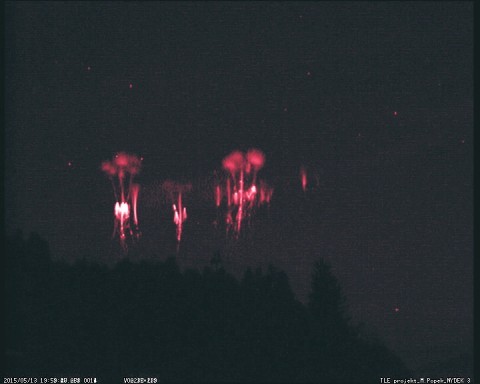Rarely seen brilliant red sprites were captured by photographers during thunderstorms last week in the Czech Republic and New Mexico.
Sprites are associated with lightning strikes but aren't actually lightning. Instead, sprites occur in the very high levels of the atmosphere above very strong thunderstorms, in the region called the mesosphere between 30 and 60 miles high. Sprites are triggered by positive cloud-to-ground lightning strikes in the storm — which is why they are most common during thunderstorm season — and typically only last a few seconds. They are usually shaped like jelly fish, columns or carrots.
"Sprites are a true space weather phenomenon," lightning scientist Oscar van der Velde of the Technical University of Catalonia, Spain, told spaceweather.com. "They develop in mid-air around 80 km [50 miles] altitude, growing in both directions, first down, then up. This happens when a fierce lightning bolt draws lots of charge from a cloud near Earth's surface. Electric fields [shoot] to the top of Earth's atmosphere - and the result is a sprite. The entire process takes about 20 milliseconds."
Sprites were first discovered by pilots during World War II. However, scientists didn't believe that the reports had any credibility, and that the pilots were not qualified to report on atmospheric phenomena they were seeing during their flights. Basically, scientists thought the pilots were crazy, says Capital Weather Gang's Don Lipman. "As a result, pilots were reluctant to come forward, believing that their reputations were at stake and that some might think them delusional," Lipman writes.

Sprites are an elusive phenomena to photograph, let alone see with the naked eye, because they occur so high in the atmosphere and are often blocked from view by the thunderstorm clouds themselves. But if there's a single thunderstorm blossoming on a clear night and you're far enough away from the storm to see above it, you might be lucky enough to capture one of nature's most fleeting light shows.




Reader Comments
to our Newsletter